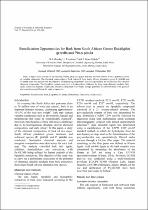 ResearchSpace
ResearchSpace
Beneficiation opportunities for bark from South African Grown Eucalyptus grandis and Pinus patula
JavaScript is disabled for your browser. Some features of this site may not work without it.
- ResearchSpace
- →
- Research Publications/Outputs
- →
- Journal Articles
- →
- View Item
| dc.contributor.author |
Moodley, RS

|
|
| dc.contributor.author |
Andrew, Jerome E

|
|
| dc.contributor.author |
Sithole, Bishop B

|
|
| dc.date.accessioned | 2018-05-29T11:27:06Z | |
| dc.date.available | 2018-05-29T11:27:06Z | |
| dc.date.issued | 2018-03 | |
| dc.identifier.citation | Moodley, R.S., Andrew, J.E. and Sithole, B.B. 2018. Beneficiation opportunities for bark from South African Grown Eucalyptus grandis and Pinus patula. Journal of Scientific & Industial Research, vol. 77(3): 176-180 | en_US |
| dc.identifier.issn | 0975-1084 | |
| dc.identifier.issn | 0022-4456 | |
| dc.identifier.uri | http://nopr.niscair.res.in/handle/123456789/43689 | |
| dc.identifier.uri | http://nopr.niscair.res.in/bitstream/123456789/43689/1/JSIR%2077%283%29%20176-180.pdf | |
| dc.identifier.uri | http://hdl.handle.net/10204/10242 | |
| dc.description | Open access article published in Journal of Scientific & Industial Research, vol. 77(3): 176-180 | en_US |
| dc.description.abstract | Bark, a major waste residue in the forestry, timber, pulp and paper industry has been shown to be a potential source of valuable chemicals. The chemical composition of bark extracted from South African plantation grown E. grandis and P. patula trees was studied with the objective of identifying components that could potentially be beneficiated into valuable chemical compounds. The lipophilic extracts were rich in hydrocarbons, followed by long chain aliphatic alcohols, fatty acids, sterols and terpenic compounds. Phenolic compounds were found in high quantities in softwood bark, with guaiacol and o-acetyl-p-cresol being the main components. | en_US |
| dc.language.iso | en | en_US |
| dc.publisher | NISCAIR-CSIR, India | en_US |
| dc.relation.ispartofseries | Worklist;20879 | |
| dc.subject | Beneficiation | en_US |
| dc.subject | Bark | en_US |
| dc.subject | E. grandis | en_US |
| dc.subject | P. patula | en_US |
| dc.subject | Biorefinery | en_US |
| dc.subject | Extractives | en_US |
| dc.subject | South Africa | en_US |
| dc.title | Beneficiation opportunities for bark from South African Grown Eucalyptus grandis and Pinus patula | en_US |
| dc.type | Article | en_US |
| dc.identifier.apacitation | Moodley, R., Andrew, J. E., & Sithole, B. B. (2018). Beneficiation opportunities for bark from South African Grown Eucalyptus grandis and Pinus patula. http://hdl.handle.net/10204/10242 | en_ZA |
| dc.identifier.chicagocitation | Moodley, RS, Jerome E Andrew, and Bishop B Sithole "Beneficiation opportunities for bark from South African Grown Eucalyptus grandis and Pinus patula." (2018) http://hdl.handle.net/10204/10242 | en_ZA |
| dc.identifier.vancouvercitation | Moodley R, Andrew JE, Sithole BB. Beneficiation opportunities for bark from South African Grown Eucalyptus grandis and Pinus patula. 2018; http://hdl.handle.net/10204/10242. | en_ZA |
| dc.identifier.ris | TY - Article AU - Moodley, RS AU - Andrew, Jerome E AU - Sithole, Bishop B AB - Bark, a major waste residue in the forestry, timber, pulp and paper industry has been shown to be a potential source of valuable chemicals. The chemical composition of bark extracted from South African plantation grown E. grandis and P. patula trees was studied with the objective of identifying components that could potentially be beneficiated into valuable chemical compounds. The lipophilic extracts were rich in hydrocarbons, followed by long chain aliphatic alcohols, fatty acids, sterols and terpenic compounds. Phenolic compounds were found in high quantities in softwood bark, with guaiacol and o-acetyl-p-cresol being the main components. DA - 2018-03 DB - ResearchSpace DP - CSIR KW - Beneficiation KW - Bark KW - E. grandis KW - P. patula KW - Biorefinery KW - Extractives KW - South Africa LK - https://researchspace.csir.co.za PY - 2018 SM - 0975-1084 SM - 0022-4456 T1 - Beneficiation opportunities for bark from South African Grown Eucalyptus grandis and Pinus patula TI - Beneficiation opportunities for bark from South African Grown Eucalyptus grandis and Pinus patula UR - http://hdl.handle.net/10204/10242 ER - | en_ZA |





